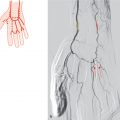3 Coronary Arteries
D. Hortung, K. Hueper
In the past two decades, the coronary arteries have been studied extensively by coronary angiography, resulting in numerous case reports on different anomalies. For references, see recent books, reviews, or descriptions of anomalies of specific patterns of general interest.1–21
The anomalies of coronary arteries can be classified by:
– The presence of accessory branches from the aorta and minor deviations in the origins.
– The presence of only a single ostium of the coronary arteries.
– The origin from the pulmonary trunk.
– Anastomoses with other arteries
– The variability of the posterior interventricular branch.
Many anomalies have no clinical significance under normal circumstances, but they can explain differences in symptoms and electrocardiography findings caused by sclerotic plaques in an anomalous coronary artery or during heart surgery. Anomalous coronary arteries seem to occur more frequently in cases of anomalies of the heart.5 These are not usually included in the percentages given in the figures.
3.1 “Normal” Situation as Described in Textbooks (~60%)

Fig. 3.1 “Normal” situation as described in textbooks (60%). Schematic (a) and coronary CTA (b-d). VR 3D images in anterior (b), superior (c), and anterior oblique (d) views. 1 Right coronary artery; 2 circumflex branch; 3 diagonal branch; 4 anterior interventricular branch; 5 left coronary artery.
3.2 Accessory Arteries and Anomalies of the Origin of the Aorta (~38%)

Fig. 3.2 Artery to the beginning of the pulmonary artery: conus artery (~37%). Schematic (a) and CTA of the thoracic aorta, VR 3D image cut at the level of the aortic root, superior view (b). 1 Right coronary artery; 2 conus artery.

Fig. 3.3 Additional artery to the septum (a. septi ventriculorum) (<0.1%). Schematic.

Fig. 3.4 Separate origin of the anterior interventricular branch and circumflex branch of the left coronary artery (<1%). Schematic (a) and contrast-enhanced CT in a patient with calcified atherosclerotic lesions of the ascending aorta and the coronary arteries (b,c). VR 3D images cut at the level of the aortic root, superior (b) and oblique transverse (c) views. 1 Pulmonary trunk; 2 circumflex branch; 3 anterior interventricular branch; 4 aorta.
Fig. 3.5 Left circumflex branch but as a branch of the right coronary artery (<1%). Schematic (a) and coronary CTA (b,c). VR 3D images, anterior (b) and posterior (c) views. 1 Right coronary artery; 2 right ventricular branch; 3 anterior interventricular branch; 4 circumflex branch; 5 diagonal branches; 6 left coronary artery.

Fig. 3.6 Left circumflex branch originates separately on the right side of the aorta (<0.1%). Schematic.

Fig. 3.7 Two separate origins of both coronary arteries (delta type) (<0.1%). Schematic.
3.3 Only One Coronary Artery Arising from the Aorta (<1%)
If the aorta has only one coronary orifice, two different types of coronary arteries can be distinguished:
–Only the first parts of both coronary arteries form a trunk, but otherwise all normal branches are present.6,18,22–32
–One coronary artery is totally absent, resulting in an anomalous blood supply to the whole heart by only one coronary artery.33 Comparable symptoms are found in patients in whom both coronary arteries originate from the same sinus of Valsalva.18,22,26,31,34–37 A coronary artery running between the aorta and pulmonary trunk or intramurally can cause intermittent angina.18,38–41 Angiological studies have shown that more patients have only one ostium for one coronary artery than have been reported in anatomical studies. Since coronary angiographies are performed only on patients with angina, a select group of patients are investigated. An anomalous course of a single coronary artery can cause exertional angina, requiring coronary angiography.

Fig. 3.8 Left coronary artery branches from the right coronary artery and runs anterior to the aorta (<0.1%). Schematic (a) and coronary CTA (b-e). VR 3D images in oblique anterior view (b,c); MIP in oblique transverse view at the origin of the coronary artery (d); and VR 3D image cut at the level of the aortic root, superior view (e). 1 Right coronary artery; 2 circumflex branch; 3 diagonal branches; 4 anterior interventricular branch; 5 aorta; 6 pulmonary trunk; 7 left coronary artery; 8 right ventricle.
Fig. 3.9 Left coronary artery branches from the right coronary artery and runs posterior to the aorta (<1%). Schematic.

Fig. 3.10 Right coronary artery branches from the left coronary artery (<0.1%). Schematic (a) and coronary CTA of two patients (b-d). Patient 1: MIP in oblique transverse view of the origin of the coronary arteries (b). Note the course of the right coronary artery between the pulmonary trunk and the ascending aorta. Patient status post replacement of the ascending aorta and the aortic valve due to aortic dissection. Patient 2: MIPs in oblique transverse view of the origin of the coronary arteries (c), and VR 3D image cut at the level of the aortic root, superior view (d). 1 Right coronary artery; 2 left coronary artery; 3 anterior interventricular branch; 4 circumflex branch; 5 aorta.

Fig. 3.11 Right coronary artery arises from the anterior interventricular branch (<0.1%). Schematic.

Fig. 3.12 Left coronary artery is absent, the heart is supplied by an extension of the right coronary artery (<0.1%). Schematic.

Fig. 3.13 Right coronary artery is absent, the left flex branch is extended and supplies the area of the right coronary artery (<0.1%). Schematic.
3.4 Origin from the Pulmonary Trunk (1%)
All six anlagen of valves in the outflow tract can have orifices for coronary arteries, thus explaining the origin of coronary arteries from the pulmonary trunk.12,42 The left coronary artery originates from the pulmonary trunk (anomalous origin of the left coronary artery from the pulmonary artery or Bland-White-Garland syndrome), approximately 10 times more often than the right. This can be explained by the fact that the left orifice is located nearer to the pulmonary trunk.11,12,23,43–59 The anomalous coronary artery often anastomoses with the normal one and, due to pressure differences, blood is shunted from the normal via the anomalous coronary artery into the pulmonary trunk. Consequently, the afflicted patient does not suffer from low oxygen tension but rather from perfusion pressure in the anomalous coronary artery. In very rare cases, coronary arteries can also arise from pulmonary arteries. A few cases have been described in which the coronary artery originated from the brachiocephalic trunk60–62 or the bronchial arteries.60,62,63

Fig. 3.14 Accessory branch from the pulmonary trunk (<1%). Schematic.
Stay updated, free articles. Join our Telegram channel

Full access? Get Clinical Tree










